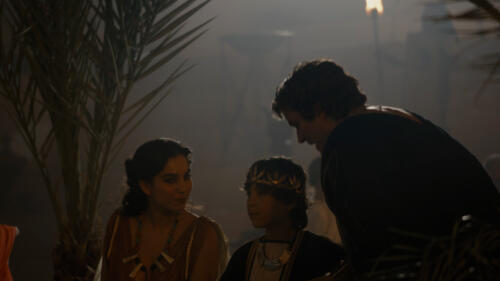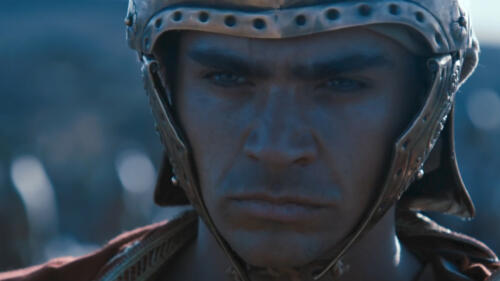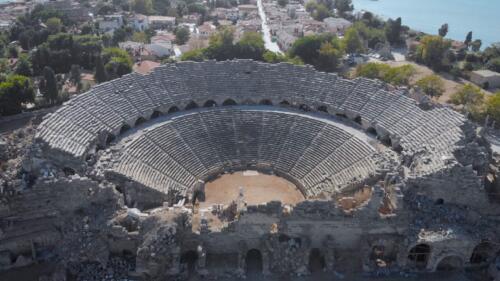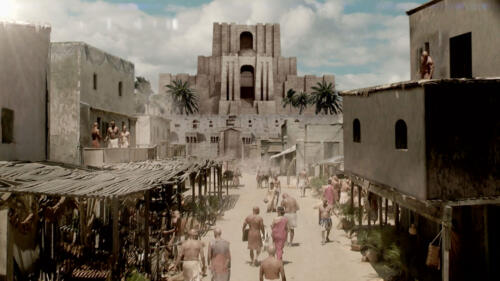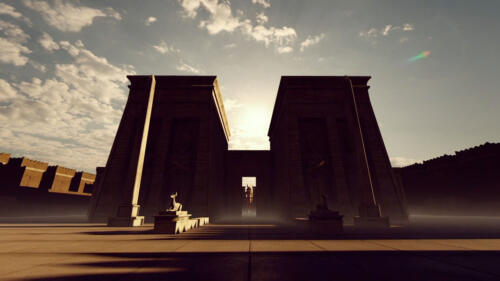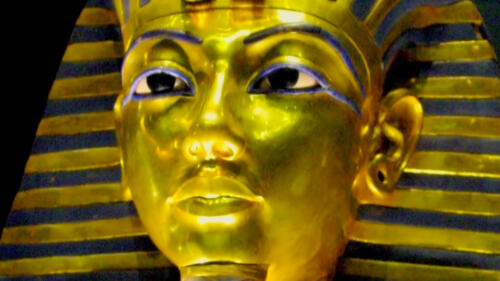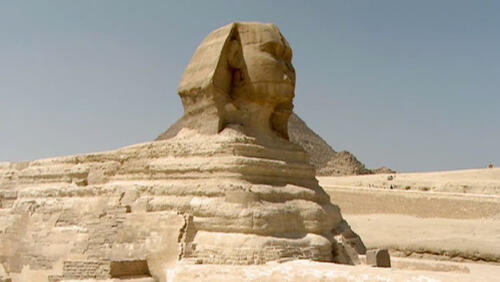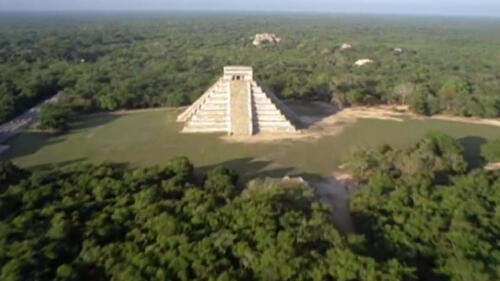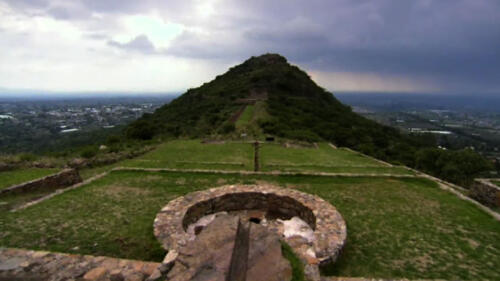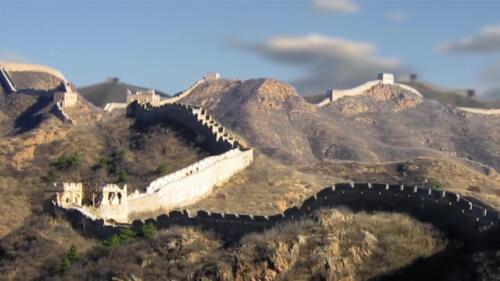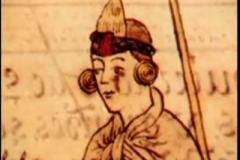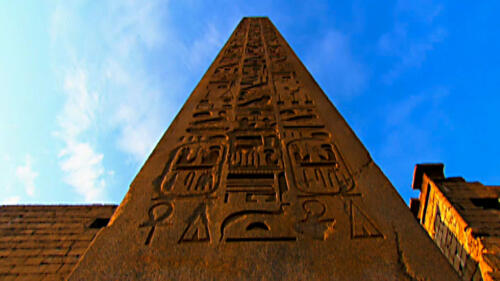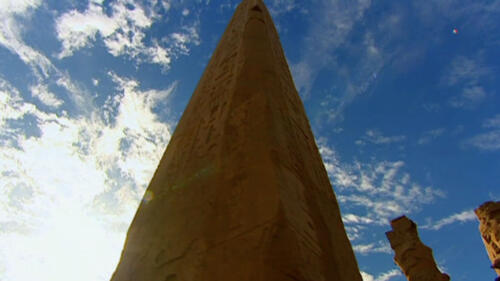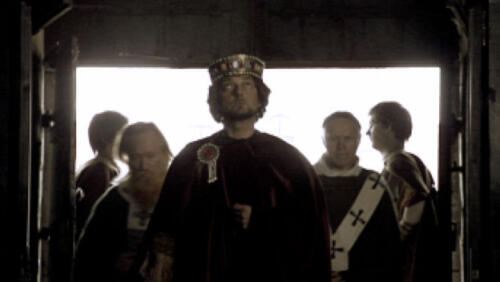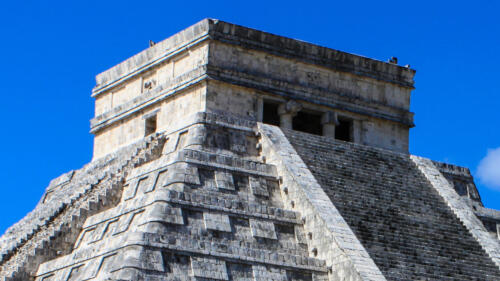Ancient History
Ancient civilizations laid the foundation for our modern world. From the majestic Egyptian pyramids to the sophisticated cities of the Maya, discover the innovations, cultures and daily life of some of history's earliest and most influential societies.

Getty Images
Start Here

For millennia, ancient Egyptian doctors were trailblazers—and evidence detected on skulls suggests its doctors may have even attempted to treat cancer.

The Romans were prodigious builders and expert civil engineers, and their thriving civilization produced advances in technology, culture and architecture that remained unequaled for centuries.

Around A.D. 250, the Maya built flourishing cities. What triggered their decline?

Despite the best efforts of amateur and professional archeologists, the ancient world has retained many of its secrets.
8 Ancient Empires
8 Ancient Empires You’ve Never Heard Of
Grab your fedora and bullwhip as we unearth 8 amazing yet obscure ancient empires, in this episode of History Countdown.
9:42 watch
Explore related articles

History is filled with tortured stories of people drinking gold, transfusing blood and taking potions to defy death.

A victim of the Mt. Vesuvius eruption was lying in his bed when a searing ash cloud swept through his city. Soon, it turned out, he had a brain of glass.

Inked-up mummies reveal that, far from a modern phenomenon, humans have been getting tattoos for thousands of years.

In Homer’s epic poem, the Greek warrior encounters cyclops, sorcerers and cannibals on his 10-year journey home from war.

Roman citizens could enter the arena for free to watch gladiator fights, mock naval battles, wild animal hunts—and plenty of death.

In Plato's 'Republic,' the ancient Greek philosopher lays out five different forms of government, ranging from ideal to oppressive.

Ancient historians describe Alexander offering prize money to those men who climbed towering cliff faces in the fastest time.

It’s been an Olympic event since 1984, but the sport formerly known as synchronized swimming, has ancient origins.

Like the Olympic Games, the Heraia race was held every four years, likely as part of a prenuptial initiation ritual.

For millennia, ancient Egyptian doctors were trailblazers—and evidence detected on skulls suggests its doctors may have even attempted to treat cancer.

A volcanic eruption and shift in climate could have triggered a series of ancient calamities—from pestilence to locusts—as described in the Bible.
Following the death of her father, Ptolemy XII Auletes, Cleopatra is crowned Queen of Egypt. Learn more in this exclusive scene from Ancient Empires.
6:02m watch
Caesar consolidated his power and made himself dictator. Learn more in this exclusive clip from Ancient Empires.
5:02m watch
Two of the most known men in the history of ancient Rome are Gaius Julius Caesar and Spartacus. Learn more in this exclusive clip from Ancient Empires.
6:13m watch
Why did Alexander the Great fail in India? Learn more in this exclusive clip from Ancient Empires.
5:06m watch
Alexander the Great lays the foundation for Egypt in this exclusive scene from Ancient Empires.
5:42m watch
The future of Macedon is at stake. See more in this clip from Season 1, Episode 1, "Alexander the Great."
8:20m watch
Julius Caesar works his way up to becoming one of the most powerful people in Rome. see more in this clip from Season 1, Episode 2, "Caesar."
10:47m watch

Thousands of years before modern railroads appeared, the Diolkos stone road featured a section of grooved tracks and spanned across the Isthmus of Corinth.

Cleopatra. Boudica. Queen Seondouk. Female rulers in antiquity were few and far between, but left powerful legacies.

People living in this Bronze Age civilization crafted unique objects that shed light on life in ancient China some 3,200 years ago.

Archaeologists decoded part of the ‘unknown’ writing system from the Kushan Empire using the same technique that helped decipher the Rosetta Stone.

Here's how Alexander, one of history's most iconic military leaders, grew the ancient Greek kingdom of Macedonia and conquered the Persian Empire.

He vastly expanded the ancient Roman empire, but his assassination led to its downfall.

To consolidate power, the last queen of Egypt married—then killed—her siblings. And she bore children with Roman allies Julius Caesar and Mark Antony.

Some instruments of torture, like the rack, were real. Others were likely made up to help perpetuate the myth of the medieval 'Dark Ages.'

The artifact, picked up by a retiree walking on a beach in Israel, depicts one of the most powerful deities of ancient Egypt.

These eight objects played a role in the daily lives of people living in the cradle of Western civilization nearly 3,000 years ago.

Jesus wasn't the only one believed to have risen from the dead. Stories of resurrection appear in ancient cultures around the world.

Despite the best efforts of amateur and professional archeologists, the ancient world has retained many of its secrets.

A priestess named Enheduanna claimed authorship to poetry and other texts—sometimes in first-person—more than a millennium before Homer.

Ancient Greek and Roman stadiums were built to impress—and their designs are seen in many college football stadiums today.

In Athens and Rome, voting could entail shouting contests, secret stone ballots and an election system with built-in bias for the wealthy.

A dagger crafted from meteorite and the remains of King Tut's stillborn daughters are among the stunning artifacts found in the tomb.

The collection of laws and regulations carved into stone thousands of years ago carries principles and ideas that are still applied today.

By some historians' measure, he was the cruelest and most demented of the bunch.

While doctors in ancient Rome prescribed macabre elixirs and used dreams for diagnoses, they also made significant medical advances.

The once-great empire on the Nile was slowly brought to its knees by a centuries-long drought, economic crises and opportunistic foreign invaders.

Architecture, agriculture, art and more first blossomed in these cultures.

Their lives and value were defined almost solely in relation to men: their fathers and husbands. But some women found ways to claim their own power.

Sure, the Roman Empire had that extensive road system. But it helped that early Christians didn't paint themselves as an exclusive club.

Hammurabi's Code may get all the attention, but barley and wool were the mainstays of Babylonian day-to-day life and commerce.

The iconic Roman structure stood as the largest and most complex permanent amphitheater in the ancient world.

A largely tolerant and merciful ruler, Persian king Cyrus the Great established one of the largest empires in world history.

Ancient Egyptians left behind a trove of artifacts that shed light on daily life during the civilization's 3000-year existence.

Who were the most renowned Roman gladiators? From slave rebel Spartacus to debauched emperor Commodus, they varied widely.
An ancient pharaoh is credited with the construction of the Abu Rawash and the Great Pyramid - both are considered to be engineering marvels, in this clip.
3:13m watch

Ancient Greek athletes competed in individual sports that placed physical prowess on display.

Chariot racing in ancient Rome showcased local teams, speed, violence and star athletes.

Queen Amanirenas commanded soldiers of the ancient Kingdom of Kush and successfully resisted Roman rule.

Roman audiences craved novelty. Females battling each other with weapons fit the bill.

The ritual grew as ownership of automobiles and then mass production of portable grills and plastic coolers soared.

These dietary staples were cultivated over thousands of years by Indigenous peoples of America.

The vibrant network opened up exchanges between far-flung cultures throughout central Eurasia.

These rulers were often as innovative and ingenious as they were brutal and corrupt.

Julius Caesar’s killers attempted to thwart a dictator. They inadvertently created an emperor.

During 200 years of relative peace and prosperity, the Roman Empire reached the peak of its political and economic power.

Felines served a useful purpose in ancient Egyptian households and were eventually associated with deities.

Caral was an architectural marvel—a 1,500-acre complex constructed by the oldest known civilization in the Western Hemisphere.

Athens developed a system in which every free Athenian man had a vote in the Assembly.

The script found on the insides of ancient Egyptian temples, monuments and tombs represents a complex remnant of history.

From nourishing agricultural soil to serving as a transportation route, the Nile was vital to ancient Egypt's civilization.
From naked athletes to foot-only races, these are 10 surprising facts you didn’t know about the ancient Olympics.
9:30m watch
Discover the true story of ancient, but lesser known, civilizations like Nineveh, Catalhoyuk, and Tiwanaku, in this episode of History Countdown.
10:35m watch

Tenochtitlán, the capital city of the Aztec Empire, flourished between A.D. 1325 and 1521—but was defeated less than two years after the arrival of Spanish invaders led by Cortés.
Some mysteries we may never find the answer to, but some are begging to be solved! From secret sunken cities to unknown texts, discover the 9 greatest unsolved mysteries of ancient history - in this episode of History Countdown.
9:10m watch
Discover these 10 incredible structures that were constructed by ancient civilizations but remain shrouded in mystery, in this episode of History Countdown.
11:25m watch

Three city-states joined in a fragile, but strategic alliance to wield tremendous power as the Aztec Empire.

From axes to swords to chariots, see the weapons that helped make ancient Egyptian warriors formidable.

Environmental factors helped agriculture, architecture and eventually a social order emerge for the first time in ancient Mesopotamia.

Philip II of Macedon's bodyguard—and former lover—wielded the knife. But 21-year-old Alexander, heir to the powerful king, quickly fell under suspicion.

Dig into the superstitions that surround King Tut’s tomb, the Hope Diamond and more.

The ancient Babylonian king ruled with military and diplomatic finesse—and he also knew a thing or two about self-promotion.

The Greek city-state imposed brutal training and contests that began at age 7.

Among tools people used in the past were moss, sponge on a stick, ceramic pieces and bamboo 'spatulas.'

The venom of an asp—or even a cobra—supposedly killed the legendary queen of Egypt. Is it true?

The huge drawings depicting human forms, birds and snakes may have served as sites for rituals and markers for travelers.

The 400-year rule of the Han Dynasty generated a slew of innovations in everything from agriculture to metallurgy to seismology.

Alexander used both military and political cunning to finally unseat the Persian superpower.

At its peak, Rome stretched over much of Europe and the Middle East.

The Sumerian people of Mesopotamia had a flair for innovation. Here's how they left their mark.

This icon of classical architecture perched atop the Acropolis has dominated the Athens skyline for 2,500 years.

These aircraft, tanks, rocket launchers and more serve as the workhorses of American warfare. One has even earned the nickname "the finger of God."

From King Tut's tomb to the pyramids, here are the greatest archaeological finds from Egypt.

These tantalizing archaeological finds may—or may not—offer material evidence of ancient locations, characters and stories written about in the Bible.

Decades of research and high-tech forensics have offered multiple theories.

An upgrade of the Boy King's burial chamber took a decade.

“His death may be the most famous case of pseudothanatos, or false diagnosis of death, ever recorded.”

Here are the most fascinating finds of the year.

The ancient tombs contained a well-preserved woman and the priest responsible for embalming the pharaohs.

The star of the Thanksgiving table was revered by the Maya.

Scientists have discovered new evidence of the ancient culture in South America.

Augustus told Romans he was the only one who could save Rome. And they believed him.

The discovery of a 4,500-year-old ramp offers clues about Egyptians' technological knowledge.

In addition to slicing out the hearts of victims and spilling their blood on temple altars, the Aztecs likely also practiced a form of ritual cannibalism.

Temples and monuments built in ancient Greece were so commanding, their ruins remain impressive thousands of years later.

Democracy in ancient Greece, introduced by the Athenian leader Cleisthenes, established voting rights for citizens, a supervising council and a jury system.

Milo of Croton reportedly ate 20 pounds of meat and drank 18 pints of wine a day to maintain his muscular physique.

Rowdy Roman chariot-race fans wore them in imitation of the fearsome Huns. And Ben Franklin used his to send a revolutionary message to the French.

Archaeologists describe a technique that the ancient Rapa Nui may have used to leverage the hats on the island's giant stone statues.

The Goths and Visigoths were Germanic tribes who fought against Roman rule, governed large swaths of territory and ushered in the the medieval period in Europe.

Delphi was an ancient religious sanctuary dedicated to the Greek god Apollo. Said to be the center of the world, the site was also home to the Oracle of Delphi.

A years-long hunt ended in disappointment—and Nefertiti’s tomb remains elusive.

These razor-sharp blades inspired fear and fascination and helped change the course of military campaigns.

The Huns were fierce warriors who terrorized much of Europe and the Roman Empire in the 4th and 5th centuries A.D., until the death of their famed king Attila.

Hint: Miracles played an important role.

Tikal is a complex of Mayan ruins in Guatemala, its 3,000 structures believed to be the remains of the powerful first millennium B.C. city of Yax Mutal.

Mycenae is the site of an ancient city in Peloponnese, Greece. The center of a Bronze Age civilization, Mycenae also featured prominently in Greek mythology.

William Shakespeare might have given Marcus Junius Brutus all the credit, but Caesar's true betrayer was a much closer friend.

The Roman Forum, located in the heart of ancient Rome, was the site of religious and social activities and home to some of the city's most impressive monuments.

Chichen Itza is a former Mayan city and current archeological site on Mexico's Yucatan Peninsula, known for pyramids like El Castillo among its preserved ruins.

Macedonia is a historic region that spans northern Greece and the Balkan Peninsula and was once the center of a sprawling empire under Alexander the Great.


From ancient Rome to contemporary Paris, the flexing of military muscle is a longstanding tradition.

The Parthenon is a marble temple built atop the Acropolis in Athens during the classical age of ancient Greece. Its Elgin Marbles are now housed in the British Museum.

Babylon, largest city of the Babylonian Empire and located in modern-day Iraq, was famed for the Hanging Gardens of Babylon, Ishtar Gate and Tower of Babel.

Ephesus, an ancient port city in modern-day Turkey, was once an important trading center in the Mediterranean region and home of the famed Temple of Artemis.

The Pantheon is one of the best-preserved monuments of ancient Rome. Completed circa 128 A.D., the structure features a rotunda with a massive domed ceiling.

The Acropolis of Athens, Greece, a UNESCO World Heritage site, has been home to kings, religious festivals and temples like the Parthenon since the Bronze Age.

The Persian Empire is the name given to a series of dynasties centered in modern-day Iran, beginning with the conquests of Cyrus the Great around 550 B.C.

Petra is an archeological site in present-day Jordan. Known for its rock-cut architecture, the city was established as a trading post in the 4th century B.C.

Hadrian's Wall is the remains of a line of stone fortifications built under Roman Emperor Hadrian following the conquest of Britain in the second century A.D.

The mysterious epidemic that devastated Aztecs may have been food poisoning.

Palmyra is an ancient archaeological site located in modern-day Syria. Originally founded near a fertile natural oasis, it was established sometime during the third millennium B.C. as the settlement of Tadmor, and it became a leading city of the Near East and a major trading post on the Silk Road.

The Ming Dynasty, which ruled China from 1368 to 1644 A.D., is remembered for establishing cultural ties with the West, its literature boom and its porcelain.

Teotihuacan is an ancient Mesoamerican city famed for its pyramids. This area of modern-day Mexico was settled as early as 400 B.C. and named by the Aztecs.

The Great Sphinx of Giza is a 4,500-year-old statue near Egypt's Great Pyramid. At 240 feet long and 66 feet high, it is one of the world's largest monuments.

The Qin Dynasty was the first royal dynasty during the age of Imperial China. Qin achievements had a profound cultural impact on the dynasties that followed.

The Han Dynasty ruled China from 206 B.C. to 220 A.D. and was the second imperial dynasty of China.

The Tang Dynasty, covering a period from the 7th to the 10th century A.D., marked a golden age of Chinese arts and culture and made an impact across Asia.

The history of chocolate and its creation from cocoa beans can be traced from the xocolatl-loving Olmec, Maya and Aztecs of Mexico to the courts of Europe.

The Shang Dynasty ruled China from 1600 to 1046 B.C. and left a record of advancements in the fields of math, astronomy, art and military technology.

Lupercalia was an ancient pagan festival held each year in Rome around February 14. It is considered a precursor to Valentine's Day.

Masada is an ancient stone fortress located high above the Dead Sea, its well-preserved ruins attesting to the history of the ancient kingdom of Israel.

Sumer was an ancient civilization founded in the Mesopotamia region of the Fertile Crescent, its people known for innovations in language, governance and more.

Saturnalia, an ancient Roman festival honoring the agricultural god Saturn, occurred in mid-December. Saturnalia rituals later became Christmas traditions.

Mesopotamia was a region of southwest Asia between the Tigris and Euphrates rivers from which human civilization and world-changing inventions emerged.

The Silk Road was a network of trade routes connecting China and the Far East with the Middle East and Europe. Established when the Han Dynasty in China officially opened trade with the West in 130 B.C., the Silk Road routes remained in use until A.D. 1453, when the Ottoman Empire boycotted trade with China and closed them.
Everyone knows how the Trojan War ended: with a bunch of guys piling out of a giant horse. But the events of the war itself have been debated extensively, and the actual truth is still largely unknown. All we have to go on is myth.
1:36m watch


Jerusalem is a city located in modern-day Israel and is considered by many to be one of the holiest places in the world. Jerusalem is a site of major significance for the three largest monotheistic religions: Judaism, Islam and Christianity. Both Israel and Palestine have claimed Jerusalem as a capital city.

From ancient Roman bacchanalia to the Shah of Iran's $175 million birthday party, these are some of history's most epic bashes.

From ancient Rome to its portrayal in popular culture, Shakespeare's famous phrase has long carried evolving symbolism and enduring significance.

New DNA research suggests a deadly form of salmonella may have been behind the collapse of the Aztec civilization.

From the Maya to Greenland’s Vikings, check out six civilizations that seemingly disappeared without a trace.

Archaeologists say a pair of dismembered, mummified legs found inside an ancient Egyptian tomb are most likely those of the famed Queen Nefertari, consort of King Ramses II.
Get an overview of the ancient leaders who oversaw the expansion and growth of civilizations around the world.
3:23m watch

Built on the orders of the Roman Emperor Hadrian and located in Great Britain, Hadrian’s Wall was a defensive fortification that marked the northwest frontier of the Roman Empire for three centuries. The wall measured 73 miles in length and stretched from coast to coast across present-day northern England, between Wallsend in the east to […]

Archaeologists working on the famed Terra Cotta Army in China believe their lifelike appearance could have been modeled on ancient Greek sculptures.

Around A.D. 250, the Maya built flourishing cities. What triggered their decline?

These pioneering writers authored some of the earliest works of history.

Scientists have confirmed that the Black Death and another huge plague epidemic in the sixth century were caused by different strains of the same bacterium.

Egypt’s oldest papyrus fragments, which detail the construction of the Great Pyramid of Giza, have gone on public display in Cairo.

From an 11,000-year-old temple complex to a mystifying Irish megalith, here are seven lesser-known world wonders that stand as a testament to the engineering prowess of the ancients.

According to the ancient historian Suetonius, the Roman emperor known as Caligula loved one of his horses, Incitatus, so much that he gave the steed a marble stall, an ivory manger, a jeweled collar and even a house. Another chronicler, Cassius Dio, later wrote that servants fed the animal oats mixed with gold flakes. Famous […]

The iron blade of an ornate dagger buried with Egypt’s King Tutankhamun in the 14th century B.C. likely came from a fallen meteorite, according to a new study.

Explore 10 fascinating facts about the medieval empire that bridged the gap between the classical world and the Renaissance.

This Celtic queen took no prisoners after Romans annexed her family's kingdom and raped her daughters.

The word “barbarian” originated in ancient Greece, and was initially used to describe all non-Greek-speaking peoples, including Persians, Egyptians, Medes and Phoenicians. The ancient Greek word “bárbaros,” from which it derives, meant “babbler,” and was onomatopoeic: In the Greek ear, speakers of a foreign tongue made unintelligible sounds (“bar bar bar”). Similar words exist in […]

CT scan images suggest that as one assailant slit Ramses III’s throat, another severed his right big toe.

The term “Gordian knot,” commonly used to describe a complex or unsolvable problem, can be traced back to a legendary chapter in the life of Alexander the Great. As the story goes, in 333 B.C. the Macedonian conqueror marched his army into the Phrygian capital of Gordium in modern day Turkey. Upon arriving in the […]

From an ancient Sumerian bulwark to the Berlin Wall, here are seven of history’s most influential manmade barriers.

It likely originated in ancient Mesopotamia.

Music is likely as old as humanity. But when was the first song recorded in history?

Check out nine fascinating facts about one of the earliest sophisticated civilizations known to history.

Much like at Pompeii, archaeologists uncovering the ancient Greek city of Selinunte have found a once-thriving metropolis frozen in time.
Ancient Rome waged many campaigns of conquest during its history, but its most influential wars may have been the ones it fought against itself.

Take a look back at six of the most damaging raids on the Eternal City.

A British archaeologist believes ancient Egypt’s Queen Nefertiti may be buried behind a secret door inside of King Tut’s tomb.

Check out 10 surprising facts about the fabled Queen of the Nile.

From Genghis Khan to Alexander the Great, get the facts on seven historical titans whose final resting places are unaccounted for.

Beginning in the late 19th century, around a dozen carved skulls made of clear or milky white quartz—also known as rock crystal—made their way into private and public collections around the globe. Since then, the origins of these “crystal skulls” have been the subject of ongoing mystery and controversy. According to the people who claimed […]

One of the most famous examples of ancient Greek sculpture, the Venus de Milo is immediately recognizable by its missing arms and popularly believed to represent Aphrodite, the Greek goddess of love and beauty, who was known to the Romans as Venus. The artwork was discovered in 1820 on the Aegean island of Melos (also […]

A replica of the lift system used to hoist and release deadly wild animals onto the Colosseum’s floor has been unveiled inside Rome’s ancient amphitheater.

Estimates suggest the project took about two decades to complete.

From medieval knights to Japanese kamikaze pilots, soldiers throughout history have yelled out intimidating and inspiring rallying cries.

British scientists have uncovered a secret at the heart of ancient Egypt’s large cache of animal mummies—many of them contain no animal remains at all.

A new examination of Julius Caesar’s health has found that the Roman dictator may have suffered from a series “mini-strokes” rather than epilepsy.

An Italian researcher has concluded that a painting some have called the ancient Egyptian equivalent of DaVinci’s “Mona Lisa” is probably a fake.

The Ancient Egyptian slab helped crack the code of hieroglyphics.

People have been chewing gum, in various forms, since ancient times.

The term democracy, which means “rule by the people,” was coined by the Greeks of ancient Athens to describe their city-state’s system of self-rule, which reached its golden age around 430 B.C. under the skilled orator and politician Pericles. It is probable that the Athenians were not the first group of people to adopt such […]

It has to do with ancient Greek mythology, the Olympics and the British royal family.

An ancient city that manages to stay inhabited—and important—over thousands of years is a surprisingly rare occurrence. Here are six of the most fascinating examples.

Explore eight surprising facts about the life of Rome’s fourth emperor.
![Chinese lute p'i-p'a, moon guitar yue-chin and table zither tchin; detail of a painting on silk of the Ming dynasty (1330-1644).', 1948. From Musical Instruments Through the Ages, by Dr. Alexander Buchner. [Spring Books, London, 1948]. Artist Unknown. (Photo by Print Collector/Getty Images)](https://res.cloudinary.com/aenetworks/image/upload/c_fill,ar_1.7777777777777777,w_640,h_360,g_auto/dpr_auto/f_auto/q_auto:eco/v1/gettyimages-1036135468?_a=BAVAZGDX0)
Check out seven surprising facts about the dynasty that made China a global power.

Explore eight illuminating facts about the first Roman emperor.

Whether revered as a divine symbol of luck and wisdom, used as unique tools of diplomacy between leaders, deployed to intimidate opposing armies or put on display in the service of status or science, elephants have loomed large in the historical record.

The longest river in the world, measured from its mouth to its most distant, year-round source, is likely the Amazon, which flows 4,345 miles from the Peruvian Andes through Brazil to the Atlantic Ocean. However, much depends on how you measure it. Until 2007, the title belonged to the Nile, which runs 4,258 miles from […]

Equal parts secret service, special forces and urban administrators, Rome’s Praetorian Guard was one of the ancient world’s most prestigious military units.

It's not always possible to separate fact and fiction about the famed ancient Macedonian ruler, but here are eight great takeaways from Alexander’s life.

Explore eight reasons why this remarkable transit system helped unite the ancient world.

Get the facts on the enigmatic men-at-arms behind Ancient Rome’s most notorious form of entertainment.

The extra day tacked on to every fourth year is a subtle admission that even something as regular and simple as a calendar can be more complicated than we think.


Find out why one of history's most legendary empires finally came crashing down.

Six surprising facts about the Egyptian boy king and his final resting place.

Find out more about the fascinating history behind one of antiquity’s most important legal codes.

Find out five fascinating facts about the man who famously proclaimed “I came, I saw, I conquered.”

From Britain’s most beloved outlaw to the founder of Sparta, find out more about six historical figures whose existence remains up for debate.

By analyzing concrete used to build 2,000-year-old Roman structures, a team of scientists discovered why it's so durable.

Today, mummies are some of the most prized and highly valued artifacts of antiquity, but it might surprise you to know that prior to the 19th century, this wasn’t always the case.

An Oxford researcher says she has found evidence of the elusive Hanging Gardens of Babylon—300 miles from Babylon.

From fitness tests for infants to state-sponsored hazing, find out why these ancient Greek warriors had a rough go of it.

Nero had many enemies and is remembered as one of history’s most sadistic and cruelest leaders. But there are a couple of problems with the story.

You’ve heard all about them, but how much of the vomitorium story is mere myth?

The Romans were prodigious builders and expert civil engineers, and their thriving civilization produced advances in technology, culture and architecture that remained unequaled for centuries.

In early 1923, British archaeologist Howard Carter and his financier friend George Herbert, Lord Carnarvon, ceremoniously opened the long-obscured burial chamber of the boy pharaoh Tutankhamen in Egypt’s Valley of the Kings. Two months later, Carnarvon was dead, killed by blood poisoning from an infected mosquito bite on his cheek. Newspapers speculated that he was […]

From the earliest recorded peace treaty to ancient board games, discover 11 surprising facts about the Gift of the Nile.
The invention of written language replaced the oral tradition and allowed civilizations to store and share knowledge.
2:22m watch

Find out whether the much-maligned emperor was as crazy as they say.

Although shrouded in myth, the ancient Olympics were surprisingly similar to the modern Olympic Games.
According to one theory, an accident caused the untimely death of teenage pharaoh King Tut. How might a broken leg have sent him to his tomb?
2:20m watch
Ancient Egyptians developed a form of aspirin 5,000 years before the advent of modern medicine.
1:07m watch
Ancient Mayans studied the skies thousands of years before modern astronomical observatories.
2:05m watch
Ancient Mayan structures have lasted thousands of years, and their designs continue to influence modern architecture.
1:35m watch
The Lighthouse at Alexandria was the first known lighthouse and stood for 1600 years on the coast of Egypt.
1:58m watch
The Aztecs built an expansive system of aqueducts that supplied water for irrigation and bathing.
2:33m watch
It took millennia to build, but today the Great Wall of China stands out as one of the world's most famous landmarks.
2:15m watch
The growth of the great Mayan civilization is as much a mystery as its disappearance.
1:36m watch
Though they could build complex suspension bridges, the Aztecs could not ward off diseases brought over by the Spanish.
1:20m watch
Ramses built the Temple at Abu Simbel in Egypt to intimidate his enemies and seat himself amongst the gods.
2:42m watch
The Mayans prospered for more than two thousand years. Today, their greatest city Palenque still stands.
2:10m watch
Workers carved the 700-ton Obelisks of Luxor from a single piece of red granite.
3:14m watch
In this Lost Worlds video, brought to you by the History Channel, learn about man's ability to come up with creative solutions to move stone throughout history. Watch as this video takes us from Egypt to Greece to Jerusalem showing us different solutions throughout history for constructing giant structures like obelisks and temples.
4:31m watch
Emperor Qin Shi Huang searched for divine acceptance by offering gifts to the gods.
3:07m watch
Legend has it that Cleopatra took her own life by succumbing willingly to the bite of a cobra. If this story is true, was suicide by snake venom an easy way to go, or did the last Egyptian pharaoh die in excruciating pain?
2:34m watch
Byzantine Emperor Justinian's plans to reunite the Roman Empire are thwarted by an unlikely foe.
3:32m watch
Explore the origins of the Temple of Chichen Itza, a Mayan pyramid in modern-day Mexico that features several unique features, including an echo designed to sound like a bird call.
3:12m watch
The Great Wall of China was constructed over several centuries and claimed the lives of thousands of builders.
3:08m watch

Greek archaeologists report that budget cuts have placed the country’s cultural heritage at risk.

Mexican and British researchers have uncovered a possible reason for the mysterious collapse of one of the Western Hemisphere's most advanced civilizations.

Dive into the world of America’s most beloved crustaceans.

The warrior Achilles is one of the great heroes of Greek mythology. According to legend, Achilles was extraordinarily strong, courageous and loyal, but he had one vulnerability–his “Achilles heel.” Homer’s epic poem the Iliad tells the story of his adventures during the last year of the Trojan War.

Hercules was a hero of Greek and Roman mythology. He succeeds at completing 12 labors of incredible difficulty, securing his eternal immortality with the gods.

Pompeii and Herculaneum were flourishing resorts on the coast of Italy until Mount Vesuvius erupted in 79 A.D., burying the cities’ ruins under tons of ash and rock.

The Great Wall of China was conceived by Emperor Qin Shi Huang in the third century B.C. and eventually spanned more than 13,000 miles across northern China.

The Byzantine Empire was a powerful nation, led by Justinian and other rulers, that carried the torch of civilization until the fall of its capital city Constantinople.

Queen Nefertiti (1370-c. 1330) ruled Ancient Egypt with her husband Akhenaten (aka Amenhotep IV). She was reknown for her beauty, as depicted by her limestone bust, one of the most recognizable works of Egyptian art.

Between about 300 and 900 A.D., the Mayan were responsible for a number of remarkable scientific achievements–in astronomy, agriculture, engineering and communications.

Ancient Greek art flourished around 450 B.C., when Athenian general Pericles used public money to support the city-state’s artists and thinkers. Pericles paid artisans to build temples and other public buildings in the city of Athens.

The Art of War is a meditation on military strategy commonly attributed to Chinese warrior Sun Tzu. Scholars remain divided as to who wrote the book and when.

The Xian Tombs of Qin Dynasty, a burial complex for 3rd century BCE Chinese Emperor Qin Shi Huang, are marked by an army of 8,000 terracotta soldiers.

Ancient Greece, the birthplace of democracy, was the source of some of the greatest literature, architecture, science and philosophy in Western civilization, and home to stunning historical sites like the Acropolis and the Parthenon.

Herodotus was a Greek writer credited with being the first historian. Sometime around 425 B.C., he published The Histories, an inquiry into the Greco-Persian Wars.

The Hellenistic period lasted from 323 B.C. until 31 B.C. Alexander the Great built an empire that stretched from Greece all the way to India, and his campaign changed the world: It spread Greek ideas and culture from the Eastern Mediterranean to Asia.

Classical Greece, a period between the Persian Wars and the death of Alexander the Great, was marked by conflict as well as political and cultural achievements.

Watch a brief video summarizing the Trojan War, the conflict recounted in Greek mythology between the kingdoms of Troy and Mycenaean Greece.

Mark Antony was a Roman politician and general known for his alliance with Julius Caesar, his rivalry with Octavian and his affair with Egypt's Queen Cleopatra.

Marcus Cicero (106-43 B.C.) was a Greek philosopher who was considered the greatest orator of the late Roman Republic. Cicero was one of the leading political figures in the era of Julius Caesar, Pompey, Marc Antony and Octavian. It was through him that the thinkers of the Renaissance and Enlightenment discovered the riches of Classical rhetoric and philosophy.

Hatshepsut oversaw ambitious building projects, including the Temple of Deir el-Bahri, during her reign in 15th century B.C. as a rare Egyptian female pharaoh.

Caligula (formally known as Gaius) was the third of Ancient Rome’s emperors, who achieved feats of waste and carnage during his four-year reign (A.D. 37-41).

Leonidas (c. 530-480 B.C.) was a king of the city-state of Sparta from about 490 B.C. until his death at the Battle of Thermopylae against the Persian army in 480 B.C. Although Leonidas lost the battle, his death at Thermopylae was seen as a heroic sacrifice because he sent most of his army away when he realized that the Persians had outmaneuvered him. Three hundred of his fellow Spartans stayed with him to fight to the end and die.

Greek mythology, and its ancient stories of gods, goddesses, heroes and monsters, is one of the oldest and most influential groups of legends in human civilization.

Sparta was a military city-state in ancient Greece that achieved regional power after Spartan warriors won the Peloponnesian War against the rival city of Athens.

Tutankhamun, or simply King Tut, ruled Egypt as pharaoh until his early death. Howard Carter found his tomb intact, setting off a worldwide Egyptology frenzy.

One of the greatest ancient historians, Thucydides (c.460 B.C.–c.400 B.C.) chronicled nearly 30 years of war and tension between Athens and Sparta. His “History of the Peloponnesian War” was a defining text of the historical genre. Unlike his near-contemporary Herodotus, Thucydides’ topic was his own time.

Socrates is one of the most exemplary and strangest of Greek philosophers who helped pave the way for other prominent thinkers including Plato and Aristotle.

The Athenian philosopher Plato (c.428-347 B.C.) is one of the most important figures of the Ancient Greek world and the entire history of Western thought. In his written dialogues he conveyed and expanded on the ideas and techniques of his teacher Socrates.

Pericles was a 5th century B.C. Athenian general and statesman who raised the grand structures of the Acropolis and turned his city's alliances into an empire.

Known for his philosophical interests, Marcus Aurelius was one of the most respected emperors in Roman history. His greatest intellectual interest was Stoicism, a philosophy that emphasized fate, reason and self-restraint.

Nero Claudius Caesar (37-68 A.D.) was one of Rome’s most infamous emperors, who ruled from 54 A.D. until his death by suicide 14 years later. Emperor Nero is best known for his debauchery, political murders, persecution of Christians and passion for music and the arts.

Built in 70 A.D., Rome's Colosseum has been the site of celebrations, sporting events and bloodshed. Today, the amphitheater is a major tourist attraction, playing host to 3.9 million visitors each year.

Hannibal was a general and statesman of Carthage who famously led his army over the Alps in 218 B.C. during the Second Punic War with Rome.

The Code of Hammurabi was one of the earliest and most complete written legal codes. It was proclaimed by the Babylonian king Hammurabi.

Alexander the Great was an ancient Macedonian ruler and one of history’s greatest military minds who before his death established a powerful, immense empire.

Cleopatra VII ruled ancient Egypt as co-regent for almost three decades. She is famed for her savvy political alliances with Julius Caesar and Mark Antony.

Augustus consolidated power after the death of Julius Caesar to become the first Roman emperor and expand the reach of an empire that lasted nearly 1,500 years.

Aristotle (384-322 B.C.) was a Greek philosopher who made significant and lasting contributions to nearly every aspect of human knowledge, from logic to biology to ethics and aesthetics.

The Punic Wars, with generals like Hannibal and Scipio Africanus, were a series of battles between ancient Rome and the city-state of Carthage in North Africa.

The Peloponnesian War (431–404 BC) was fought for nearly a half-century between Athens and Sparta, ancient Greece’s leading city-states.

The Battle of Marathon in northeastern Attica is one of history's earliest recorded battles. The fighting in 490 B.C. marked the first blows of the Greco-Persian War. The victory of “the Marathon men” captured the collective imagination of the Greeks, with the tale of the messenger running 25 miles to Athens to deliver the news fueling the creation of the modern marathon.

Famous tombs around the world include the Egyptian tombs, Jesus’ burial ground in Jerusalem, the Prophet’s Mosque and many more.

The Maya, a civilization of Indigenous people in Central America, created a complex Mayan calendar and massive pyramids before their empire collapsed into ruins.

Famous Latin American pyramids, which date back to 1,000 B.C., include the Castillo at Chichén Itzá in the Yucatan and the Inca’s great temple at Cuzco in Peru.

The Seven Wonders of the Ancient World is a list of remarkable constructions of classical antiquity. Of the original Seven Wonders, only one—the Great Pyramid of Giza—remains intact.

Julius Caesar was a general, politician and scholar who became dictator of ancient Rome until he was assassinated in 44 B.C., inspiring a play by Shakespeare.

The Aztecs ruled much of Mexico from the 13th century until their conquest by Hernán Cortés in 1521.

Attila the Hun was the leader of the Hunnic Empire from 434 to 453. Also called Flagellum Dei, or the “scourge of God,” Attila was known to Romans for his brutality and a penchant for sacking and pillaging Roman cities.

Built during a time when Egypt was one of the richest and most powerful civilizations in the world, the pyramids—especially the Great Pyramids of Giza—are some of the most magnificent man-made structures in history.

The Roman Empire, founded in 27 B.C., was a vast and powerful domain that gave rise to the culture, laws, technologies and institutions that continue to define Western civilization.

Ancient Egypt was the preeminent civilization in the Mediterranean world from around 3100 B.C. to its conquest in 332 B.C.
